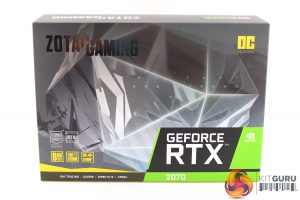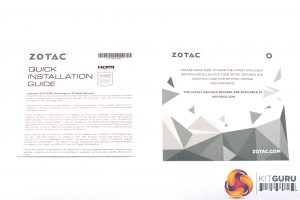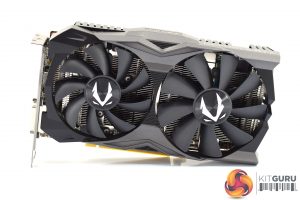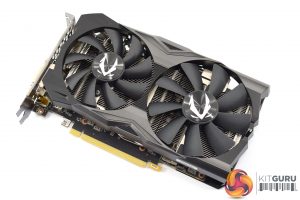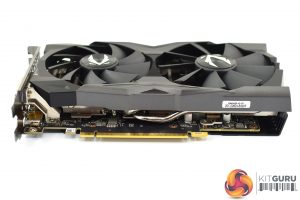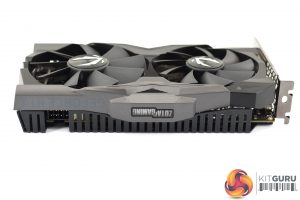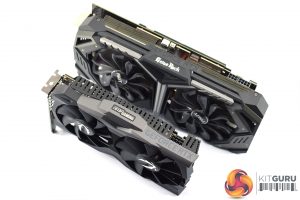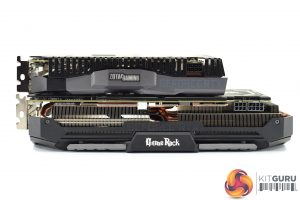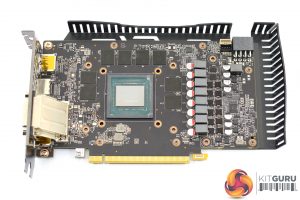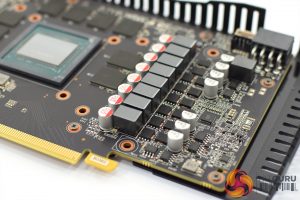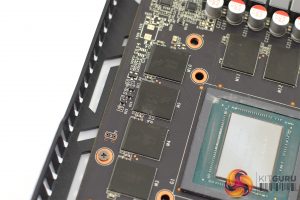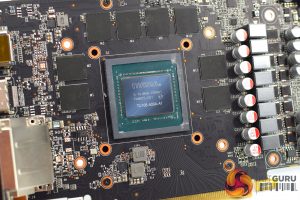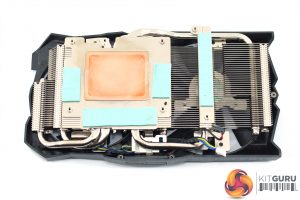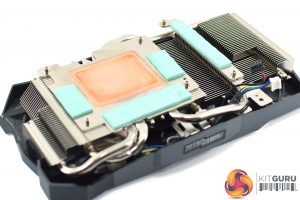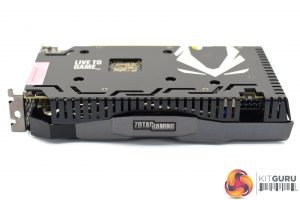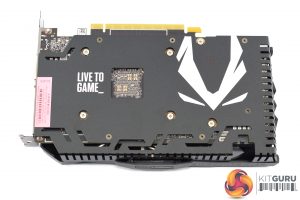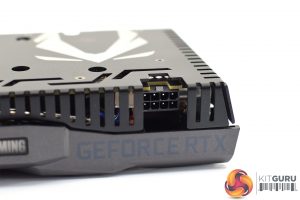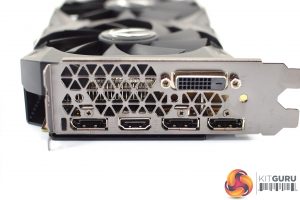The Zotac Gaming RTX 2070 OC Mini ships in a mostly grey box, with some kind of an interesting geometric design going on on the front, though there is no image of the card itself visible.
Inside, we get very little in the way of accessories – just a quick installation guide and a small note about using the latest drivers come included in the box.
The card itself is what we are here for, though, and overall I have to say it is pretty good looking, though nothing special. The plastic shroud is a combination of gunmetal grey and black which won't cause any issues in a colour coordinated build, but I do have to say the shroud itself does feel a bit flimsy and you can feel it bend and move when you pick the card up.
Two fans occupy the bulk of the front of the card, and you can see they are both different sizes and different blade designs. The fan on the left measures 90mm and has a swept blade design, whereas the fan on the right measures 100mm and has a straighter, flatter blade design. We asked Zotac about the reasoning behind this, and at the time of publication we are still waiting for an official response, but my guess is that the different fans are each designed to give slightly different air pressure levels to aid cooling of the GPU core, VRMs and memory chips as well as potentially reduce air turbulence.
Now, in terms of dimensions, this is obviously a very small card – it measures 211mm x 129mm x 41mm. That makes it the smallest RTX card I have reviewed by far, and I think you would be very hard pressed to find a case that this doesn't fit in – it's not only very short, but its thickness makes it a standard 2-slot card, instead of the 2.5 or even 2.7 slot cards we are used to seeing.
Above you can see also see two pictures of the Zotac Mini compared to the Palit RTX 2070 GameRock Premium to really highlight this size difference – both are 2070s, yet one is a very short and dinky 2-slot card, while the other is almost 30cm long and effectively a triple-slot card. They obviously have different target audiences, but it really does highlight the dimensions of this Zotac card.
To get to the PCB, just 6 screws need to be removed from the back of the card. The first thing to note is that the PCB isn't even as long as the shroud/backplate – according to my measurements, the PCB itself is 187mm long, with the extra 24mm-or so of space taken up by the heatsink and backplate design.
Elsewhere, Zotac has stuck with 6+2 power phases – the same as Nvidia's Founders Edition 2070 cards, and our 8GB of GDDR6 memory comes from Micron, with the chips labelled ‘8SA77D9WCW'. The GPU die is labelled TU106-400A, signifying it is a binned chip suitable to be sold with a factory overclock – though as we mentioned, Zotac has not been very adventurous with it by adding just 30MHz to the core compared to reference speeds.
The heatsink makes use of 5 nickel-plated heatpipes, and they all look like they measure 6mm. Given the size of the card, the aluminium fin stack is not thick dense at all, and I am very interested to see how hot this card runs – but we will get to that later in the review.
The GPU die contacts with a copper coldplate, while there is a separate coldplate surrounding that for the VRAM chips, and one more for the card's MOSFETs as well. Thermal pads are used for the VRAM chips and the MOSFETs.
On the front side of the card, a small Zotac Gaming logo occupies the middle of the plastic shroud, while you can just about make out the GeForce RTX branding to the right of that. The backplate also extends downwards to meet the plastic shroud, meaning there is no gap between the shroud and the backplate.
If we look at the backplate, it is relatively simple – it appears to be made of anodised aluminium, with just a small cut-out behind the GPU core. To the left of that, ‘LIVE TO GAME' has been printed in white text, while Zotac's logo (which appears to be some kind of mask or face) takes up the right-hand side of the backplate, again printed in white.
This Zotac card is also notable as it is the first RTX 2070 card we have seen to ship with a single 8-pin PCIe power connector – all the others have used 1x 8-pin and 1x 6-pin designs.
In terms of I/O, we find 3x DisplayPorts, 1x HDMI and 1x DVI-D – but interestingly no USB-C which has quickly become standard for RTX cards.
 KitGuru KitGuru.net – Tech News | Hardware News | Hardware Reviews | IOS | Mobile | Gaming | Graphics Cards
KitGuru KitGuru.net – Tech News | Hardware News | Hardware Reviews | IOS | Mobile | Gaming | Graphics Cards
